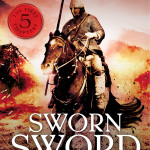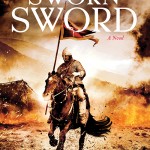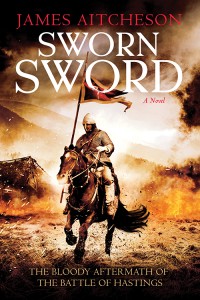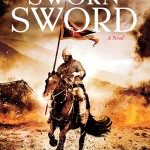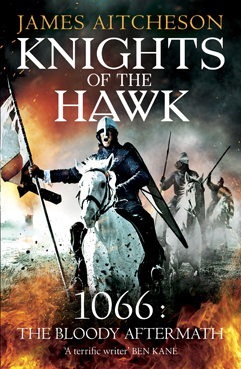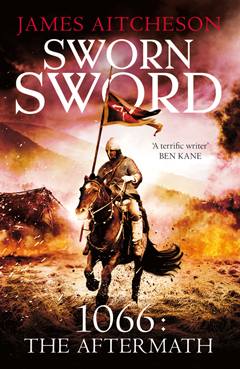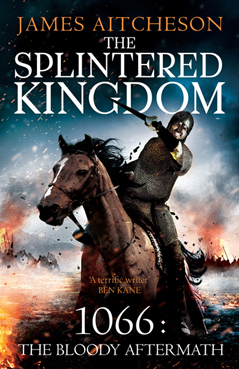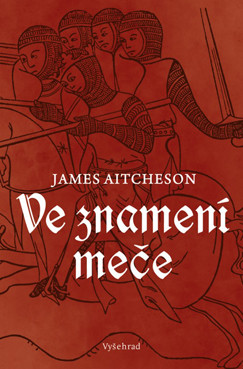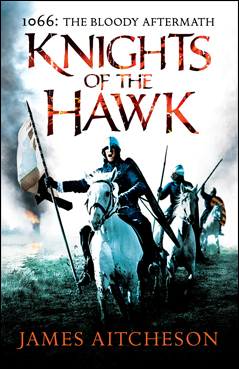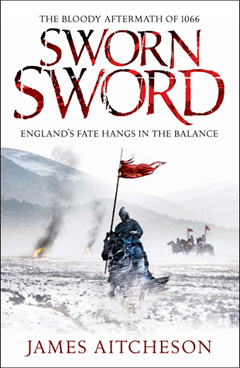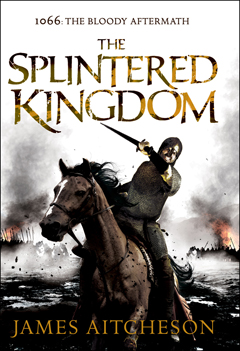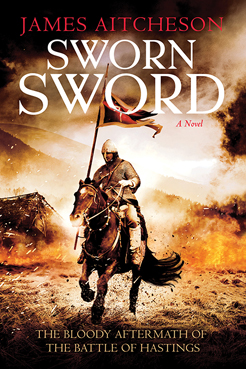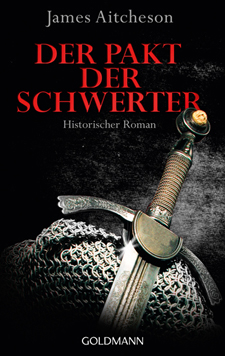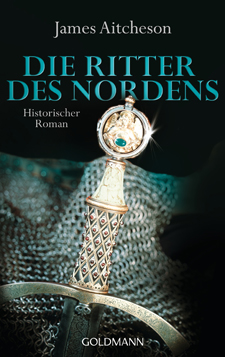“The sword-path is never a straight road, but rather ever-changing, encompassing many twists and turns. All a man can do is follow it and see where it leads.”
In a little less than a month’s time, Knights of the Hawk, the third instalment in my Conquest Series featuring the knight Tancred, will be released in the United States in hardcover.
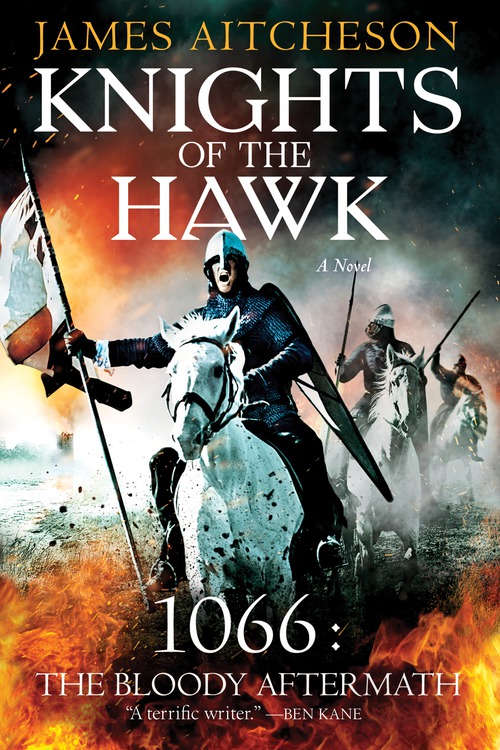
Knights of the Hawk • James Aitcheson
Sourcebooks Landmark • 416 pp. • Hardcover • $24.99
Like the previous two volumes in the series, the book will be published by the excellent team at Sourcebooks Landmark, with whom I’ve had the immense pleasure of working over the last three years, and will be available from all good bookstores and online retailers from August 4th.

The cathedral at Ely, built on the site of the Anglo-Saxon monastery which Hereward and his fellow rebels established as their base in the fight against the Normans.
The novel begins during the siege of the Isle of Ely, where the infamous English outlaw Hereward the Wake has gathered a band of rebels to make one final, last-ditch stand against the Normans.
As King William’s attempts to assault the rebels’ island stronghold end in disaster, however, the campaign begins to stall. With morale in camp failing, the king turns to Tancred to deliver the victory that will crush the rebels once and for all and bring England firmly within his grasp. But events are conspiring against Tancred, and soon he stands to lose everything he has fought so hard to gain.
“It is in those final hours, when the prospect of battle has become real and the time for hard spearwork is suddenly close at hand, that a man feels most alone, and when doubt and dread begin to creep into his thoughts. No matter how many foes he has laid low, or how long he has trodden the sword-path, he begins to question whether he is good enough, or whether, in fact, his time has come.”
Also, keep a look out for the U.S. paperback edition of The Splintered Kingdom, which will be published by Sourcebooks Landmark in November. I’ll be posting more information about that in the coming months.
“They came at first light, when the eastern skies were still gray and before anyone on the manor had risen. Shadows lay across the land: across the hall upon the mound and the fields surrounding it, across the river and the woods and the great dyke beyond that runs from sea to sea. And it was from those shadows that they came upon Earnford, with swords and knives and axes…”

The Splintered Kingdom
James Aitcheson • Sourcebooks
416 pp. • Hardcover • $24.99
Set in England in 1070, one year on from the end of Sworn Sword, it once more features the ambitious Norman knight Tancred, who has been rewarded for his exploits with a lordship in the turbulent Welsh borderlands. But his hard-fought gains are soon placed in peril as a coalition of enemies both old and new prepares to march against King William. With English, Welsh and Viking forces gathering and war looming, Tancred is chosen to spearhead a perilous expedition. Success will bring him glory beyond his dreams; failure will mean the ruin of the reputation he has worked so hard to forge. As shield walls clash and the kingdom burns, not only his Tancred’s destiny at stake, but also that of England itself.
Like all my novels, The Splintered Kingdom can be read as a standalone adventure, so you don’t necessarily have to read Sworn Sword first in order to follow what’s going on. As always, e-book editions are available on all platforms for the more digitally inclined. Both the physical and the electronic versions also include a sneak preview of the third novel in the series, Knights of the Hawk, which is already scheduled to be published by Sourcebooks Landmark in 2015.
If you’re interested in finding more about the Welsh borderlands, where The Splintered Kingdom takes place, I’ve just published a mini-history of the region in the Tancred’s England section of my website – my historical guide to England as it was c.1066. It’s a project that I’m constantly developing and which I’m looking to expand over the coming months, with entries on some of the other places visited by Tancred in the course of his travels.
Tell your friends! Today, the brand new paperback edition of Sworn Sword will be hitting bookshelves across the United States. Featuring an updated, more vibrant cover design (similar to the UK paperback cover; see below right), it also contains a short excerpt from the sequel, The Splintered Kingdom, which is due to be published this August and of which I’ll be posting more details here in the next few months.
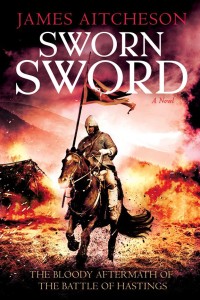
Sworn Sword • James Aitcheson • Sourcebooks Landmark • 400 pp.
Trade paperback • $14.99
I’m pleased to say, as well, that Sworn Sword has been picking up excellent reviews since its hardback publication last summer, including one in Publishers Weekly and another recently in the Philadelphia Inquirer. Thanks to all those of you who have kindly taken the time to email me through the Contact page or sent messages on Twitter and Facebook to say how much you’ve enjoyed the book and are looking forward to Tancred’s further adventures. He and his brothers-in-arms will ride again in the not-too-distant future!
If you already own the hardcover edition of Sworn Sword and can’t wait until August to find out where Tancred’s travels will be taking him in The Splintered Kingdom, you can find the synopsis as well as the first chapter, which is available to download for free, here.
The Normans are coming! Not content with conquering England, they now have their sights set on the USA as well…
And their campaign begins today with the Stateside release of Sworn Sword in both hardcover and eBook editions, courtesy of the hard-working people at my publisher Sourcebooks Landmark, who have done an absolutely fantastic job of making the book a reality.
As readers in the UK already know well, Sworn Sword is the first instalment in the Conquest Series, which tells the story of the violent and treacherous years immediately following the Norman invasion of England in 1066, when rebellion gripped the kingdom and its fate hung in the balance. As will become clear, the fateful Battle of Hastings was not the end of the struggle for England; in fact, it was just the beginning.
Based on real-life events, the series follows the career of the ambitious young knight Tancred, who is hungry for battle, for glory and for vengeance after his lord is murdered by English rebels. To find out more, have a look at the cover blurb and download the first chapter from Sworn Sword to whet your appetite.
The second in the series, The Splintered Kingdom, will be published in the US in summer 2014, followed by Knights of the Hawk in summer 2015, so there are plenty of Norman Conquest-related adventures to look forward to! As always, I’ll be posting the latest information about the novels as and when I have it, so keep checking back from time to time to see what’s new.
Based on real-life events, Sworn Sword tells the story of the great rebellions that swept England in the years after 1066, as seen through the eyes of a Norman knight named Tancred, who seeks vengeance after his lord is killed by English rebels.
Published by Sourcebooks Landmark, it’ll be available from all good bookstores and, of course, online as well, in both hardcover and eBook editions. Here’s the full synopsis:
January, 1069. Less than three years after the Battle of Hastings in 1066 and the death of the usurper, Harold Godwineson, two thousand Normans march in the depths of winter to subdue the troublesome province of Northumbria. Tancred a Dinant,a loyal and ambitious knight, is among them, hungry for battle, honor, silver, and land.
But at Durham, the Normans are ambushed in the streets by English rebels, and Tancred’s revered lord Robert de Commines is slain. Badly wounded, Tancred barely escapes with his own life. Bitterly determined to seek vengeance for his lord’s murder, the dauntless knight quickly becomes entrenched in secret dealings between a powerful Norman magnate and a shadow from the past.
As the Norman and English armies prepare to clash, Tancred uncovers a cunning plot that harks back to the day of Hastings itself. If successful, it threatens to destroy the entire conquest-and change the course of history.
This stunning debut sweeps readers into a ruthless, formidable world, where violent warriors seek honor in holy places and holy men seek glory in dark deeds. As the two opposing forces battle for conquest, the fate of England hangs in the balance.
Battles and betrayals abound, and there’s also a touch of romance, too – something, I hope, for everyone. And if that’s whetted your appetite, here’s the first chapter to give a further taste of what’s in store.
All this week the Historical Novel Society has been commemorating the anniversary of the Battle of Hastings, which took place 945 years ago today. As well as running a 1066-themed competition, the Society has also collected together a series of specially written articles about some of the lesser known figures of the Norman Conquest – figures who perhaps deserve to be better remembered – by novelists and historians specialising in the period.
Since my own series of novels is told through Norman rather than English eyes, my choice of subject is one of the invaders: William fitz Osbern, the Conqueror’s oldest and most loyal advisor, who acted as his right-hand man in Normandy and England both before and after the invasion.
Fitz Osbern was of a similar age to his namesake Duke William, which is to say he would have been around forty at the time of the invasion in 1066. The two probably grew up together in the ducal household, where his father had served as steward: a role that Fitz Osbern himself would later inherit. He and the duke formed a close friendship, and by 1066 he was one of the most powerful men in Normandy, with extensive lands centred around the town of Breteuil. He was also a regular part of the duke’s retinue, as evidenced by the large number of charters he attested.
In fact if we are to believe later sources, the Conquest might not have happened at all had it not been for Fitz Osbern. According to the twelfth-century poet and historian Wace, after news arrived at the Norman court that Harold had seized the throne, it was he who convinced the uncertain and despondent Duke William of the need to follow through with his intention to invade England and claim the crown. Indeed he went so far as to openly chastise him, saying:
“A worthy man must not begin anything or set anything in motion only to abandon it. Either start something and bring it to fruition or leave everything without more ado.”
Convincing William was the first challenge; the second was to secure the support of the other Norman barons, many of whom were less than enthusiastic about the proposed invasion, which they saw as a risky adventure. Again, as Wace tells the story, it was Fitz Osbern who brought order to the squabbling barons and persuaded them contribute the necessary men and ships.
Exactly how much truth lies behind either of these tales is hard to say; they originated many years after the events and so must be taken with a pinch of salt. At the very least they are suggestive of Fitz Osbern’s influence, showing that he was remembered in later generations for his extensive authority and for the respect he commanded from the Conqueror, in whose company he could speak freely: as a friend and equal rather than as a vassal.
After 1066 Fitz Osbern’s estates were much increased and his authority was extended across much of southern England. Along the Welsh borders he became known as a great builder of castles, and he was also later made castellan at York, although his activities elsewhere suggest that he cannot have spent much time in those parts of the country.
In 1067 the newly-crowned king returned to his native land to celebrate his victory. Fitz Osbern was entrusted, along with the Conqueror’s half brother Odo, with the governance of England, and in the king’s absence the two men became the enforcers of his rule. “Swollen with pride”, as the English-born chronicler Orderic Vitalis describes them, they proceeded to subdue the kingdom in brutal fashion. As Orderic relates:
When their men-at-arms were guilty of plunder and rape, they protected them by force and wreaked their wrath all the more violently upon those who complained of the cruel wrongs they suffered.
The other side of Fitz Osbern’s character thus presents itself: as well as being loyal and reliable, he also possessed a ruthless streak. For these acts of violence Orderic roundly condemned him; Wace later described him as “a very arrogant man”. Indeed it was his arrogance which was to prove his undoing.
In 1071 a struggle for the succession broke out in neighbouring Flanders between the young Count Arnulf and his uncle Robert. Fitz Osbern, who was at the time in Normandy governing the duchy with Queen Matilda, responded by riding to the count’s aid, albeit “as if to a tournament” with only ten knights accompanying him. At Cassel in late February he was ambushed and killed: an abrupt and embarrassing end for such a famed and powerful man.
How his career might have played out had he not died then, we can only speculate. Would his power have extended even further over the years to come as the nascent Anglo-Norman realm was consolidated?
For all his brutality, pride and recklessness, Fitz Osbern was remembered by contemporaries as a man of good character, great physical prowess and unwavering loyalty. Even Orderic conceded that he was greatly mourned by the Normans, and found space to admire his bravery and generosity. Perhaps the greatest commendation of all, however, comes from another twelfth-century historian, William of Malmesbury, who described Fitz Osbern as “better than the very best princes” – high praise indeed.
*
For more articles about some of the lesser known protagonists of the Conquest period, as well as links to other online resources for 1066, visit the HNS Competitions blog. To find out more about the Historical Novel Society itself, visit its website.



